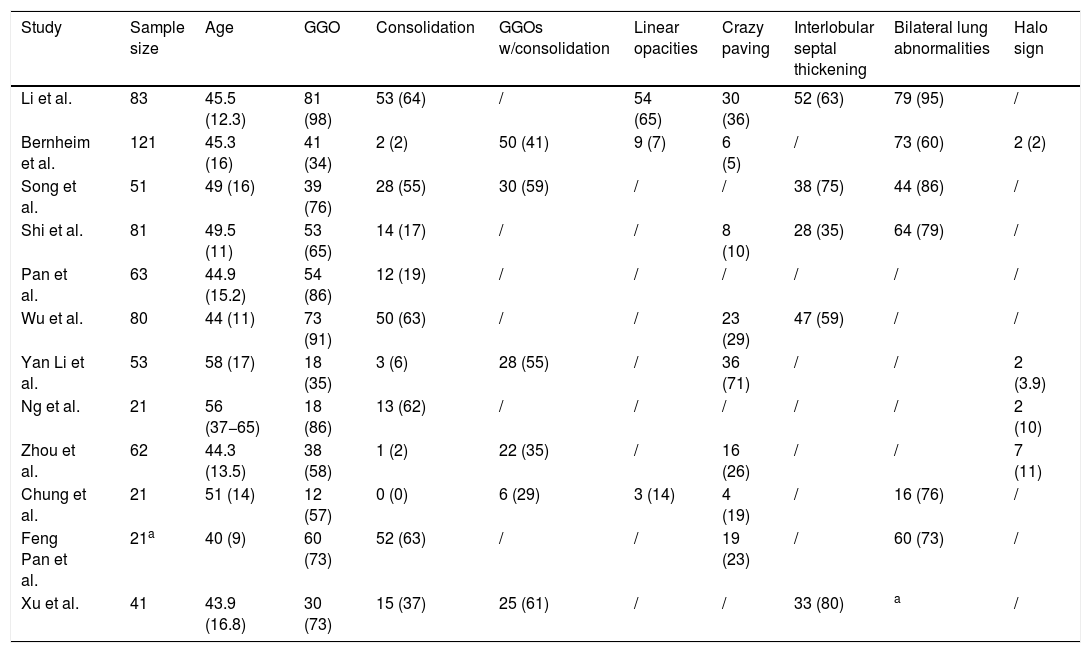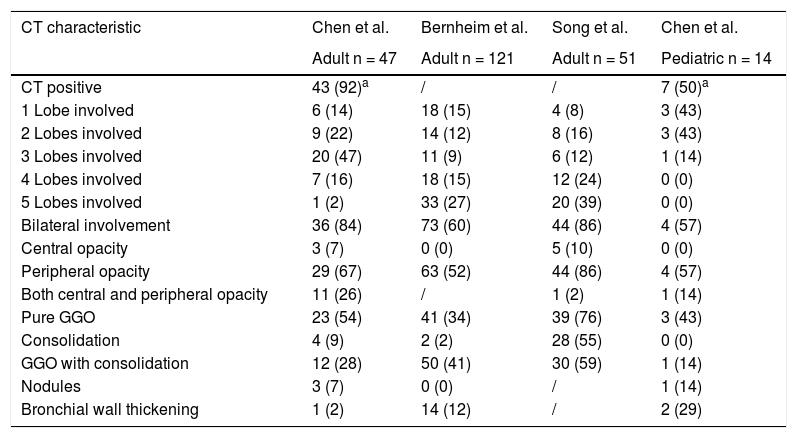Initial COVID-19 reports described a variety of clinical presentations, but lower respiratory abnormalities are most common and chest CT findings differ between adult and pediatric patients. We aim to summarize early CT findings to inform healthcare providers on the frequency of COVID-19 manifestations specific to adult or pediatric patients, and to determine if the sensitivity of CT justifies its use in these populations.
MethodsPubMed was searched for the presence of the words “CT, imaging, COVID-19” in the title or abstract, and 17 large-scale PubMed and/or Scopus studies and case reports published between January 1, 2020 and April 15, 2020 were selected for data synthesis.
ResultsInitial CT scans identified ground-glass opacities and bilateral abnormalities as more frequent in adults (74%, n = 698, and 89%, n = 378, respectively) than children (60%, n = 25, and 37%, n = 46). At 14+ days, CT scans evidenced varied degrees of improvement in adults but no resolution until at least 26 days after the onset of flu-like symptoms. In pediatric patients, a third (n = 9) showed additional small nodular GGOs limited to a single lobe 3–5 days after an initial CT scan.
ConclusionEarly adult CT findings suggest the limited use of CT as a supplemental tool in diagnosing COVID-19 in symptomatic adult patients, with a particular focus on identifying right and left lower lobe abnormalities, GGOs, and interlobular septal thickening. Early pediatric CT findings suggest against the use of CT if RT-PCR is available given its significantly lower sensitivity in this population and radiation exposure.
Los informes iniciales de la COVID-19 describieron diversas presentaciones clínicas, pero las anomalías de las vías respiratorias bajas son las más frecuentes y los hallazgos de la tomografía computarizada (TC) de tórax difieren entre pacientes adultos y pediátricos. Nuestro objetivo es resumir los hallazgos tempranos de la TC para informar a los profesionales sanitarios sobre la frecuencia de manifestaciones específicas de la COVID-19 en los pacientes adultos o pediátricos, y determinar si la sensibilidad de la TC justifica su uso en estas poblaciones.
MétodosSe buscó en PubMed la presencia de las palabras “TC”, “técnicas de imagen”, “COVID-19” en el título o en el resumen y se seleccionaron para la síntesis de datos 17 estudios a gran escala de PubMed y/o Scopus y casos clínicos publicados entre el 1 de enero de 2020 y el 15 de abril de 2020.
ResultadosLas TC iniciales identificaron que las opacidades en vidrio esmerilado (OVE) y las anomalías bilaterales eran más frecuentes en los adultos (74%, n = 698 y 89%, n = 378, respectivamente) que en los niños (60%, n = 25 y 37%, n = 46). A partir de los 14 días, las TC evidenciaron diversos grados de mejoría en los adultos, pero no se observó resolución hasta al menos 26 días después del inicio de los síntomas seudogripales. En los pacientes pediátricos, un tercio (n = 9) mostró pequeñas OVE nodulares adicionales limitadas a un solo lóbulo 3–5 días después de una TC inicial.
ConclusiónLos primeros hallazgos de la TC en adultos sugieren el uso limitado de la TC como herramienta complementaria en el diagnóstico de la COVID-19 en pacientes adultos sintomáticos, con especial atención a la identificación de las anomalías de los lóbulos inferiores derecho e izquierdo, las OVE y el engrosamiento del tabique interlobulillar. Los primeros hallazgos de la TC pediátrica desaconsejan el uso de la TC si se dispone de RT-PCR, debido a su sensibilidad significativamente menor en esta población y a la exposición a radiación.














